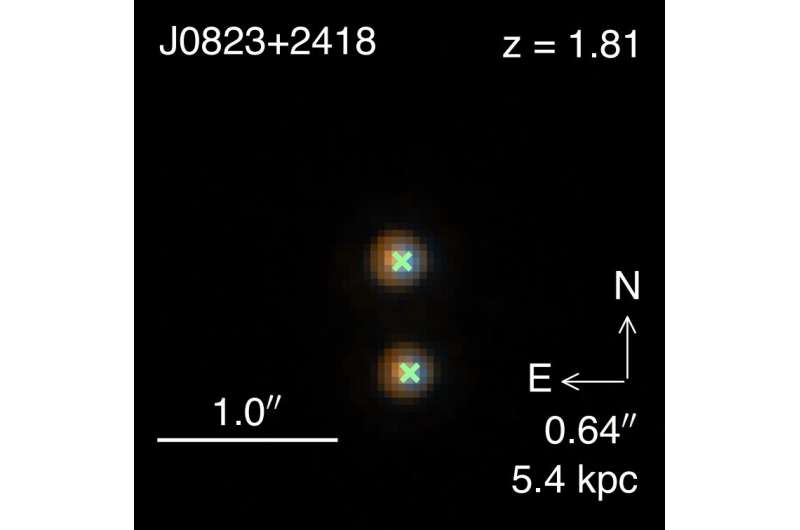June 14, 2023 report
This article has been reviewed according to Science X's editorial process and policies. Editors have highlighted the following attributes while ensuring the content's credibility:
fact-checked
preprint
trusted source
proofread
Astronomers investigate the true nature of quasar SDSS J0823+2418 with VODKA

By conducting Varstrometry for Off-nucleus and Dual sub-Kpc AGN (VODKA), astronomers from the University of Illinois at Urbana-Champaign and elsewhere, have investigated a quasar known as SDSS J0823+2418. The study, published June 6 on the pre-print server arXiv, yields important insights into the true nature of this quasar.
Quasars, or quasi-stellar objects (QSOs) are active galactic nuclei (AGN) of very high luminosity, emitting electromagnetic radiation observable in radio, infrared, visible, ultraviolet and X-ray wavelengths. They are among the brightest and most distant objects in the known universe, and serve as fundamental tools for numerous studies in astrophysics as well as cosmology. For instance, quasars have been used to investigate the large-scale structure of the universe and the era of reionization. They also improved our understanding of the dynamics of supermassive black holes and the intergalactic medium.
At a redshift of 1.81, SDSS J0823+2418 is a peculiar source, whose nature is still uncertain. Previous observations have suggested that it may be a dual quasar or a single quasar gravitationally lensed by a foreground galaxy. One of the methods that could be helpful in the verification of these two hypotheses is varstrometry.
"Varstrometry relies on variable jitters in the astrometric centroid position of an unresolved source over a series of observations. Such a signature can indicate the presence of two separate sources with intrinsic photometric variability, making it possible to compile samples of candidate dual quasars at kiloparsec-scale physical separations," writes Arran C. Gross, the lead author of the study.
The imaging of SDSS J0823+2418 shows that it consists of two sources, designated "N" and "S," separated by approximately 0.64 arcseconds. Previous studies detected differences in fluxes at a given wavelength between the two sources. This would suggest that SDSS J0823+2418 is composed of two unique sources forming a dual quasar system. However, the researchers noted that if the flux ratio is constant as a function of wavelength, then the difference might be due to wavelength-independent lensing magnification.
The new study found consistent flux ratios (about 1.25−1.45) between the N and S sources in optical, near-infrared, ultraviolet, and radio bands, and therefore similar spectral energy distributions (SEDs), which suggests a strong gravitational lensing. This is confirmed by subsequent lens modeling, showing that the best-fit positions and magnitudes from image decomposition are consistent with the strong lensing scenario.
The astronomers noted that SDSS J0823+2418 is thus one of only some 100 verified gravitationally lensed quasars at a high redshift. They underlined that their findings regarding SDSS J0823+2418 may pave the way for further quasar studies from the VODKA program, which may prove that the overall dual quasar population is overestimated.
More information: Arran C. Gross et al, Varstrometry for Off-nucleus and Dual sub-Kpc AGN (VODKA): Investigating the Nature of J0823+2418 at z=1.81: a Likely Lensed Quasar, arXiv (2023). DOI: 10.48550/arxiv.2306.04041
Journal information: arXiv
© 2023 Science X Network





















